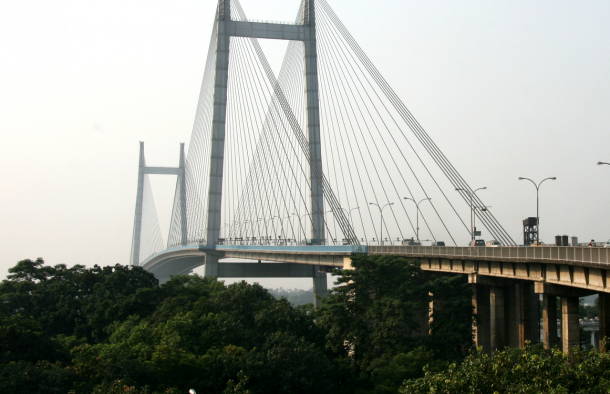India’s Infrastructure Partnership: “A Huge Footprint all over Society”
Roger Bootle brilliantly described him (or her) as homo economicus: “a bloodless utility maximising machine, trying to increase pleasure and reduce pain in its own selfish interest…a being that has never set foot on the earth but has left a huge footprint all over society.” But in truth, market economics are not as atomistic as this in practice: major public infrastructure projects, in particular, would never be started let alone completed if commissioning decisions were left solely to the iron instincts of our heavy footed homo economicus. And that’s why a group of economists and market leaders gathered in Mumbai last week to discuss the practicalities of infrastructure planning in India.
Infrastructure is now the engine room of India’s burgeoning economy: enormous projects taking place across the length and breadth of the country that are creating unprecedented levels of wealth and employment whilst at the same time delivering key facilities to facilitate further growth in the future. The Indian Government is now a world leader in both seeing and exploiting this vast potential. Over the last five years it has embarked on a public infrastructure programme on a breathtaking scale: including the biggest highway project in the subcontinent’s history with 83,677 kilometers of new road slated to be built over the next five years (compare that with the United Kingdom’s total motorway network of a little over 3,000 kilometers) added to which there are new port facilities, new airports, new aeroplanes for a newly nationalized airline and even futuristic high speed monorail networks in Delhi and Mumbai.
Our eminent gathering in Mumbai wasn’t slow to see all that potential. They rightly concluded that proper evaluation of the monetary value of public projects of this kind is not simply a matter of short or even medium term cash flow. The projects have an inherent potential to create substantial value through increased connectivity between financiers, communities and the various stakeholders involved in the enterprise and designing systems that are capable of optimising this upside connectivity is of critical importance to effective financing of infrastructure assets.
Governmental agencies, for example, have to work closely in conjunction with Export Credit Agencies, which play such a significant role in easing capital provision by lowering the cost of long-dated debt and responding to funding deficits. Neither party can do both on their own. It is a true partnership of interests and India is providing perfect examples of just how well the process can work in practice.
Take the National Highways Authority and its Toll-Operated Transfer Model, which was run in conjunction with private sector interests and significantly increased the ability to fund new Highway Projects. Given it has always proved tough to attract long-dated capital such as pension funds and insurance companies, direct government participation in the construction phase has become increasingly important: acting as a honey pot for capital pooling and monetisation and this in turn providing the government with flexible funding sources for new infrastructure investment. Covered Bonds are an important part of that process, just as they have been in Western European and North American economies for the last fifty years and the pooled character of the bonds again provides a perfect example of just how effective collaborative funding can be in the infrastructure sector.
The striking success of this symbiotic and essentially Government driven process is attracting foreign investment as well. ABB India announced this month that it is increasing its railway infrastructure programme as well as stepping up participation in renewable energy. The company already spends up to $100 Million annually on the subcontinent. ABB’s Sanjeev Sharma was in no doubt about the significance of infrastructure projects to future growth: “India has become a global feeder factory."
India is leaving a Huge Footprint on the Global Economic stage.
Red Ribbon Asset Management has been specialising in India’s Markets since the company was founded more than a decade ago, bringing an unparalleled expertise to its investment policies on the subcontinent with specialist sectoral advisers working from it’s Head Office in London in conjunction with more than a hundred local experts on the ground in the subcontinent itself. And by drawing on that body of expertise Red Ribbon's Private Equity Fund now offers an opportunity to secure above market rate returns in this, the fastest growing large economy in the World.
[nectar_btn size="large" open_new_tab="true" button_style="regular" button_color_2="Accent-Color" icon_family="none" url="http://bit.ly/PrivateEquityFundIndia" text="India Private Equity Fund"][nectar_btn size="large" open_new_tab="true" button_style="regular" button_color_2="Accent-Color" icon_family="none" url="https://redribbon.co/investment-products/" text="Investment Products"]
Red Ribbon CEO, Suchit Punnose said:
Infrastructure matters greatly to any modern economy and, as the article points out, the huge sums currently being invested into projects on the subcontinent are now playing in key role in the explosive growth of India’s economy. But it is fair to ask how a billion dollar project can sensibly be funded if returns in the short term are necessarily limited: investing in a rail network might after all leave capital costs to be recovered over a decade or more.
The answer lies in a new form of partnership between government agencies and the private sector, a subtle model for long and short term pooled resourcing that India is indeed proving to be a world leader in deploying. That can only be good for the long-term health of the economy.
It is, indeed, a huge footprint on the global economic stage and one that we would do well to pay attention to.
[social_buttons full_width_icons="true" facebook="true" twitter="true" google_plus="true" linkedin="true" pinterest="true"]








Leave a Reply